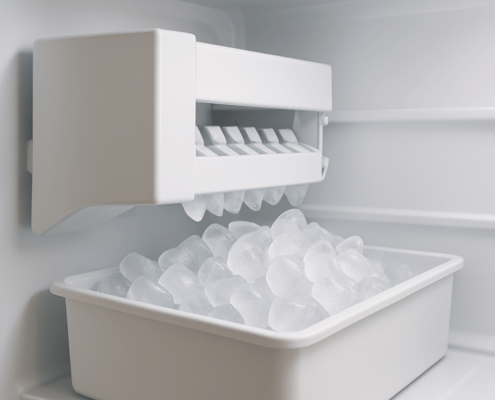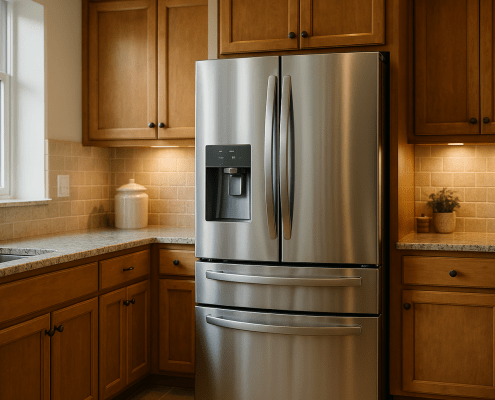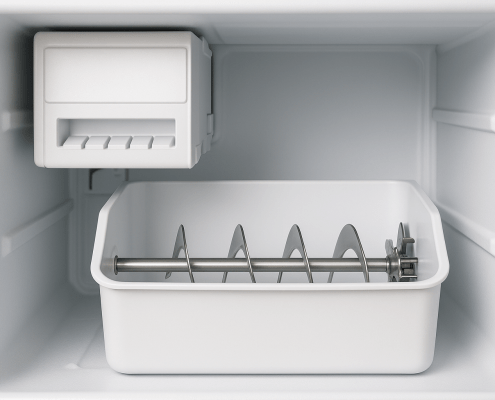How To Replace A Refrigerator Thermostat (With Video!)
APP Expert / Friday February 11, 2022
Is your refrigerator refusing to keep things cold? Before you let a failing thermostat put a dent in your wallet with costly repairs, discover how you can tackle the fix yourself with just a few basic tools. Dive into our step-by-step guide and watch the accompanying how-to video below to save money and restore your fridge to its frosty glory.
Need a replacement refrigerator thermostat/cold control? Search below using your specific fridge model number to identify the exact part needed:
Your refrigerator’s one job is keeping things cool, so if it isn’t managing that, you’ve got a pretty big problem. Luckily, sometimes big problems have small, easy solutions. If your refrigerator’s trouble is a bum thermostat, you can probably save yourself a hefty repair bill by replacing the part yourself. Don’t let the prospect of some DIY scare you off. The thermostat is an easy part to change out, requiring only a few very basic tools to replace. Check out our tutorial and the companion video guide for a complete walkthrough on the process and you’ll have your refrigerator back in working order in no time at all!
How To Tell If A Temperature Control Is Bad
When your refrigerator’s thermostat goes bad, it’s usually because one of the delicate components in the temperature control is broken – like contacts or the capillary wire. Small components like this can’t be repaired. You just have to replace the entire thermostat. But, how do you tell if it’s the thermostat causing issues?
Most obviously, a bad thermostat will cause your refrigerator’s temperature to be off. It won’t hold cold air, or it’ll wind up way too cold. There are a couple of other signs, too, though. Pay attention to your refrigerator throughout the day. Is the compressor – that’s the thing that makes the humming noise in the back of your fridge – running constantly or not running at all? A damaged thermostat could be causing this issue.
Once you know the thermostat is to blame, it’s just a matter of getting the right replacement part and fixing it yourself!
Finding The Right Replacement Part
For the most reliable repair, get a genuine OEM replacement thermostat. It’ll ensure a perfect fit and exact calibration for your model of refrigerator. You can find tons of genuine OEM replacement parts at AppliancePartsPros.com, you’ll just need your refrigerator’s model number to track them down.
To get your fridge’s model number, either consult the manual or look on the refrigerator for a label. The model number sticker can usually be found in one of these places on your appliance:
- On the exterior door or sides of the appliance
- Inside the door or on the door frame
- On the interior ceiling of the freezer or refrigerator compartment
- On the inside wall of either compartment
- On the fridge floor, beneath the crisper drawers
- Behind the kickplate at the bottom of the appliance
Order from AppliancePartsPros.com and you should have your new part in just a few days! Once you’ve got it, the repair itself is incredibly easy. Let’s take a look.
How To Replace A Refrigerator Thermostat
We completed this repair on a Whirlpool side-by-side fridge. While our tutorial will be most accurate for other side-by-side refrigerators, the thermostat can be found in roughly the same place regardless of your refrigerator brand or style. You should be able to follow these steps to replace the cold control in your fridge whether it’s a French door or a freezer-on-top model.
If you do find that something doesn’t line up right, you can consult your appliance’s manual for diagrams that can point you in the direction you need.
Tools for the job
To replace this part, you’ll need to gather a few tools. Here’s what you’ll want to have handy:
- A compatible replacement thermostat
- Phillips and flathead screwdrivers
- ¼” nut driver
- Work gloves
Before you begin
Safety first! To avoid electrocution, remember to disconnect your appliance from power either at the wall outlet or circuit breaker.
This is a relatively quick and easy job, but you will be working with the refrigerator door open, and you will need access to the back wall of your refrigerator compartment as well as the front. Clear off at least the top shelf and store the food elsewhere. You may want to just empty your fridge completely before beginning repairs to save yourself the trouble of spills or spoiled food. If you’re concerned that something might not hold while you work, regardless of where you store it in the fridge, move any food or refrigerated medication that could potentially spoil to coolers before you start. You’ll be able to put them back once you’ve completed your repairs.
With that done, we can get to the repair!
Replacing A Fridge Thermostat
- Open the refrigerator door and look at the back of the fridge compartment. The damper assembly and thermostat are in the back of your fridge, probably covered by one or two plastic covers. We’ll be removing both of those to free these parts up.
- Remove the screws holding the damper assembly covers in place. You may only see one Phillips head screw at first. Remove this one, remove the cover it was holding in place, and you’ll find the other screw holding the other cover in place. Remove that screw and cover, as well and set them aside.
- Back at the front of the fridge, you need to remove the temperature control panel. This will allow you to remove the damper assembly and thermostat. Here’s how to do that:
- Remove the four screws holding the control panel in place. You’ll find them in the ceiling of the refrigerator compartment directly behind the control panel. You’ll likely need a ¼” nut driver to remove these. If you’re having trouble finding them, you can use your phone’s front-facing camera to get a better look at where they are.
- Pry the temperature control knobs off the control panel with a flathead screwdriver. Be careful so you don’t damage the plastic. These should pop back into place easily once you’re assembling everything again.
- Pry the front trim off with a flathead screwdriver. Carefully wedge the screwdriver between the top of the fridge frame and the front panel and work your way across to free up the trim. Don’t force it as you could damage the trim.
- Remove the two mounting screws on the front of the control assembly using your nut driver.
- Now you should be able to pull the control panel away from the ceiling of the fridge compartment. It’s still held in place by wires, though, so don’t pull on it too hard.
- At this point, it’s a good idea to take a picture of the wires and how they connect to the temperature control. This will give you a solid visual reference for when you’re reassembling things later.
- Your next step is to remove the bracket holding the temperature control in place. You should be able to remove these screws from the underside of the control panel.
- Disconnect the wires on the temperature control, but before you do, if you haven’t already, take a picture with your phone so you have a reference for how everything should be put back in place.
- You should have two sets of wires connected to terminals on one side. You can pry these off with a flathead screwdriver if they don’t come off by hand.
- Remove the ground wire on the opposite side. You should be able to just pull this off.
- Lift the bracket slightly and remove the screws holding the temperature control in place. You’ll need your nut driver to remove the two ¼” screws holding this part in place.
- Remove the capillary tube. This is a plastic tube with a wire running through it that runs from the temperature control back to the damper assembly. Follow the line of the capillary tube, freeing it from the clips holding it in place.
- Once you reach the damper assembly, you should be able to just pop the capillary tube out of the clips holding it in place to completely remove the capillary tube and temperature control from the fridge.
- Prep the new thermostat.
- Straighten the old capillary wire out and remove the plastic sleeve.
- Carefully unwind the new capillary wire. Make sure you don’t kink or bend it in any way, as it is hollow, and if it’s damaged it won’t report the proper temperature.
- Feed the plastic tubing up the new capillary. Be careful when you do this – you don’t want to kink the capillary wire! The end of the capillary tube needs to be right at the mouth of the plastic sleeve. If the sleeve is too long, you can carefully trim it to an appropriate length.
- Put the control into place in the fridge and start running the capillary tube back toward the back of the fridge. You don’t have to completely install the capillary tube yet, though.
- Instead, reinstall the screws that mount the temperature control to the bracket. Make sure the bracket is behind the temperature control’s tabs so everything fits right when you put the control panel back together again.
- Remount the bracket itself, making sure the cam switch matches up to the notch on the lever before installing the screws.
- Time to reconnect the wires. Start with the grounding wire and then put the other two wire sets on their terminals.
- Finish reinstalling the capillary. You can push the control panel up into place and thread the screws to get it out of way as you thread the capillary tube back through any securing clips and reattach it to the damper assembly. The tube will need to go over the assembly and wrap around it before snapping into place.
- Reinstall the covers for the damper assembly and capillary tube. You may need to seat some tabs for them to fit properly into place.
- Put the control panel back into place on the ceiling of the fridge compartment and reinstall all the control panel mounting screws if you haven’t yet so that the assembly is secure.
- Reinstall the control panel trim. It has a number of tabs that will snap into place.
- Reinstall the temperature control knobs. You can do this by hand, but you will need to make sure you install each one correctly. The refrigerator temperature control knob will likely look a bit different from the freezer temperature control knob.
- Look at the back of the fridge temperature control knob. One side will be narrower than the other, and you’ll need to line that up appropriately.
- The freezer control knob is D-shaped, so this should be relatively easy to line up and press into place.
- Test both knobs before you consider this part done. Can you turn them in both directions without too much resistance? Don’t forget to set each of them to an appropriate temperature!
- Plug your refrigerator back in, make sure it’s running, and put your food back – you’re done! You may want to keep an eye on your refrigerator for the next few hours. It won’t chill back to an appropriate temperature immediately, so you want to make sure it does get there.
Wrapping Up
If your refrigerator returns to a proper temperature and the compressor seems to be back to normal, you can count that as a successful repair! We hope this how-to has helped you out, and if you need a bit more guidance on this particular task, don’t forget to check out our tutorial video. It provides a detailed look at how the job is done.
If you need any replacement parts for your appliances, you can enter your model number at AppliancePartsPros.com to locate and order them quickly. Most orders arrive in just two business days, and we have tons of great information in our repair help section and YouTube videos to help you troubleshoot.
Stay connected with the latest DIY tips, tutorial videos, and repair guides by following us on Facebook, Instagram, and Twitter. We love hearing about your repair stories and successes. If you need more help or want personalized guidance, feel free to contact or call us at 877-477-7278. We’re ready to help you take on your next project with confidence!
Since 1999, AppliancePartsPros.com has helped millions of people repair their broken appliances by providing high-quality original parts at well below retail prices, free support and troubleshooting, and award-winning customer service from an expert, friendly, US-based customer support team!
Hi! I’m Matt H., and I’m thrilled to be your guide through the world of appliance repair with over 25 years of invaluable experience in the industry.
From the early days of my career, I have been deeply passionate about appliances and their inner workings. Over the years, I’ve seen it all – from vintage models to the latest cutting-edge technology – and I’ve dedicated myself to mastering the art of repair. With a toolbox in one hand and a wealth of knowledge in the other, I’ve tackled every challenge that has come my way, learning and growing with each repair.
Join me as we dive into the intricacies of appliance repair. From step-by-step repair guides to explanations of common problems and their solutions, I’ll be here to simplify the repair process and empower you with the knowledge you need to keep your appliances running smoothly.
Feel free to explore our blog, ask questions, and leave comments – this platform is a space for learning, sharing, and growing together. Let’s work together to ensure that your appliances continue to serve you for years to come.
Thank you for joining me on this journey, and I look forward to being your go-to resource for all things related to appliance repair!





